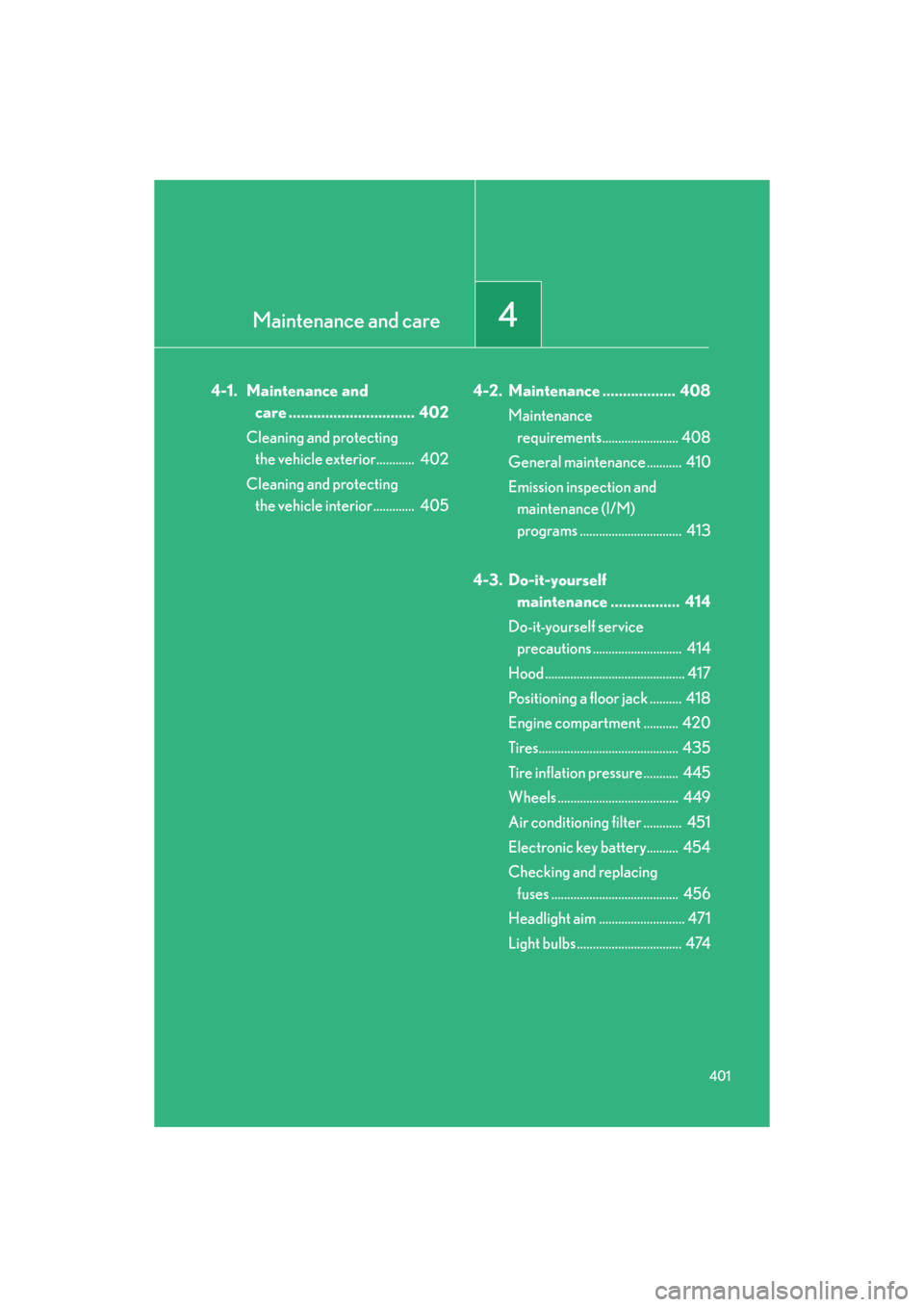Page 324 of 596
324
3-4. Using the hands-free system (for cellular phone)
GS_HV_U
December 13, 2007 10:51 am
To u c h .Input the number.
If repeated tone symbols* are
stored in the phone book,
and are displayed on the
right side of the screen.
*: Repeated tone symbols are sym-bols or numbers displayed as p
or w, that come after the phone
number.
(e.g. 056133p0123w#1
✽)
Confirm the number displayed on screen, and touch .
If you touch , operation is completed without making a call.
■ To transfer a call
To u c h .
■ To hang up
Touch or press on the steering wheel.
STEP1
STEP2
STEP3
Page 401 of 596

Maintenance and care4
401
GS_HV_U
December 12, 2007 3:30 pm
4-1. Maintenance and
care ............................... 402
Cleaning and protecting
the vehicle exterior............ 402
Cleaning and protecting
the vehicle interior ............. 405 4-2. Maintenance .................. 408
Maintenance
requirements........................ 408
General maintenance ........... 410
Emission inspection and
maintenance (I/M)
programs ................................ 413
4-3. Do-it-yourself
maintenance ................. 414
Do-it-yourself service
precautions ............................ 414
Hood ............................................ 417
Positioning a floor jack .......... 418
Engine compartment ........... 420
Tires............................................ 435
Tire inflation pressure........... 445
Wheels ...................................... 449
Air conditioning filter ............ 451
Electronic key battery.......... 454
Checking and replacing
fuses ........................................ 456
Headlight aim ........................... 471
Light bulbs ................................. 474
Page 402 of 596

402
GS_HV_U
May 13, 2008 3:19 pm
4-1. Maintenance and care
Cleaning and protecting the vehicle exterior
■Automatic car washes
●Fold the mirrors back before washing the vehicle.
●Brushes used in automatic car washes may scratch the vehicle surface and
harm your vehicle’s paint.
●Before entering an automatic car wash, check that the fuel filler door is closed.
■High pressure washers
Do not allow the nozzles of the washers to come within close proximity of the win-
dows and fuel filler door.
Perform the following to protect the vehicle and maintain it in prime condi-
tion.
● Working from top to bottom, liber ally apply water to the vehicle
body, wheel wells and underside of the vehicle to remove any dirt
and dust.
Wash the vehicle body using a sponge or soft cloth, such as a chamois.
● For hard-to-remove marks, use car wash soap and rinse thor-
oughly with water.
● Wipe away any water.
● Wax the vehicle when the waterproof coating deteriorates.
If water does not bead on a clean surface, apply wax when the vehicle
body is cool.
Page 403 of 596

403
4-1. Maintenance and care
4
Maintenance and care
GS_HV_U
May 13, 2008 3:19 pm
■Aluminum wheels
Remove any dirt immediately by using a neutral detergent. Do not use hard brushes
or abrasive cleaners. Do not use strong or harsh chemical cleaners. Use the same
mild detergent and wax as used on the paint.
■Bumpers and side moldings
Do not scrub with abrasive cleaners.
■To prevent paint deterioration and corrosion on the body
●Wash the vehicle immediately in the following cases:
• After driving near the sea coast
• After driving on salted roads
• If you see coal tar or tree sap on the paint surface
• If you see dead insects, insect droppings or bird droppings on the paint
• After driving in an area contaminated with soot, oily smoke, mine dust, iron
powder or chemical substances
• If the vehicle becomes heavily soiled in dust or mud
• If liquids such as benzene and gasoline are spilled on the paint surface
●If the paint is chipped or scratched, have it repaired immediately.
■Touch-up paint (if equipped)
Apply the touch-up paint to cover small sc ratches or chips, and to prevent rust.
CAUTION
■Caution about the exhaust pipe
Exhaust gasses cause the exhaust pipe to become quite hot.
When washing the vehicle, be careful not to touch the pipe until it has cooled suffi-
ciently, as touching a hot exhaust pipe can cause burns.
Page 411 of 596

411
4-2. Maintenance
4
Maintenance and care
GS_HV_U
December 12, 2007 3:50 pm
Vehicle interior
ItemsCheck points
Accelerator pedal• Moves smoothly (without uneven pedal effort or catching)?
Transmission “Park”
mechanism• Can the vehicle be hold securely on an incline with the shift lever in “P”?
Brake pedal
• Moves smoothly?
• Does it have appropriate clearance and correct amount of free play?
Brakes
• Pulls to one side when applied?
• Loss of brake effectiveness?
• Spongy feeling brake pedal?
• Pedal almost touches floor?
Head restraints• Move smoothly and lock securely?
Indicators/buzzers• Function properly?
Lights• Do all the lights come on?
• Headlights aimed correctly? ( P. 4 7 1 )
Pa r k i n g b r a ke
• Moves smoothly?
• Can hold the vehicle securely on an
incline?
Seat belts
• Does the seat belt system operate smoothly?
• Are the belts undamaged?
Seats• Do the seat controls operate properly?
Steering wheel
• Moves smoothly?
• Has correct free play?
• No strange noises?
Page 412 of 596
412
4-2. Maintenance
GS_HV_U
December 12, 2007 3:50 pm
Vehicle exterior
ItemsCheck points
Doors/trunk• Operate smoothly?
Engine hood• The lock system works properly?
Fluid leaks• Is there any leakage after parking?
Ti r e
• Inflation pressure is correct?
• Tire surfaces not worn or dam-aged?
• Tires rotated according to the
maintenance schedule?
• Wheel nuts are not loose?
CAUTION
■If the hybrid system is running
Turn off the hybrid system and ensure that there is adequate ventilation before per-
forming maintenance checks.
Page 436 of 596

436
4-3. Do-it-yourself maintenance
GS_HV_U
December 27, 2007 1:38 pm
Installing tire pressure warning valves and transmittersWhen replacing tires or wheels, tire pressure warning valves and trans-
mitters must also be installed.
When new tire pressure warning va lves and transmitters are installed,
new tire pressure warning valve and transmitter ID codes must be regis-
tered in the tire pressure warning computer and tire pressure warning
system must be initialized. Have tire pressure warning valve and transmit-
ter ID codes registered by your Lexus dealer. ( P. 4 3 8 )
Initializing the tire pressure warning system
■ The tire pressure warning system must be initialized in the following
circumstances:
● When rotating the tires on vehicles differing with front and rear tire
inflation pressures.
● When changing the tire inflation pressure by changing traveling
speed or load weight, etc.
When the tire pressure warning sys tem is initialized, the current tire
inflation pressure is set as the pressure benchmark.
Page 439 of 596

439
4-3. Do-it-yourself maintenance
4
Maintenance and care
GS_HV_U
December 27, 2007 1:38 pm
■When to replace your vehicle’s tires
Tires should be replaced if:
●You have tire damage such as cuts, splits, cracks deep enough to expose the
fabric or bulges indicating internal damage
●A tire goes flat repeatedly or cannot be properly repaired due to the size or
location of a cut or other damage
If you are not sure, consult with your Lexus dealer.
■Replacing tires and wheels
If the ID code of the tire pressure warn ing valve and transmitter is not registered,
the tire pressure warning system will not work properly. After driving for about 20
minutes, the tire pressure warning light comes on after blinking for 1 minute to indi-
cate a system malfunction.
■Tire life
Any tire over 6 years old must be checked by a qualified technician even if they
have seldom or never been used or damage is not obvious.
■If the tread wears down below 0.16 in. (4 mm) on snow tires
The effectiveness of snow tires is lost.
■Low profile tires (245/40R18, P245/40R18 and 245/40ZR18 tires)
Generally, low profile tires will wear more rapidly and tire grip performance will be
reduced on snowy and/or icy roads when co mpared to standard tires. Be sure to
use snow tires or snow chains on snowy and/or icy roads and drive carefully at a
speed appropriate for road and weather conditions.
■Initializing the tire pressure warning system
Initialize the tires with the tire inflatio n pressure adjusted to the specified level.